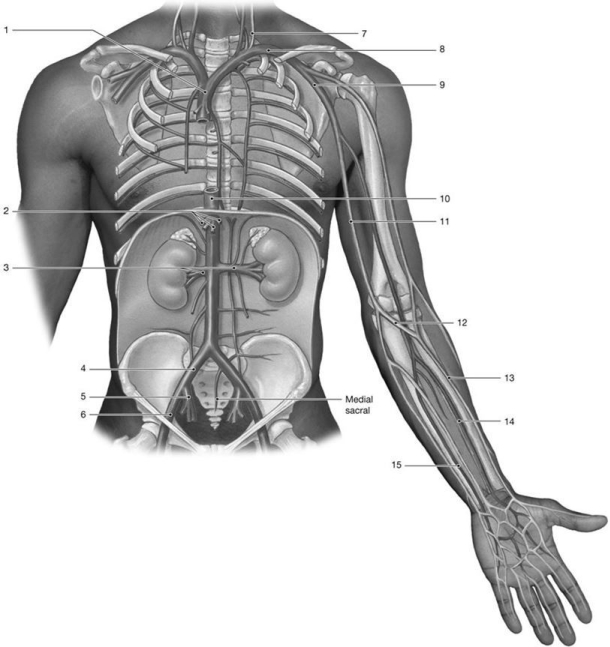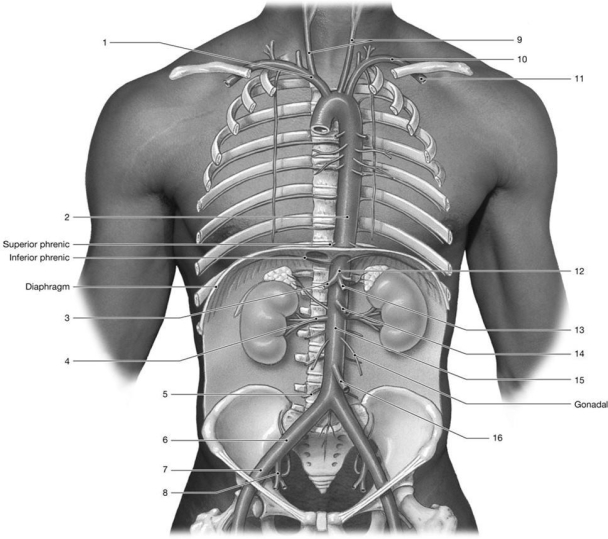A) arteries.
B) arterioles.
C) capillaries.
D) venules.
E) veins.
G) A) and B)
Correct Answer

verified
Correct Answer
verified
Multiple Choice
Total peripheral resistance is affected primarily by
A) blood vessel diameter.
B) blood vessel length.
C) blood viscosity.
D) venous pressure.
E) turbulence.
G) C) and D)
Correct Answer

verified
Correct Answer
verified
Multiple Choice
Each of the following changes will result in increased blood flow to a tissue except
A) increased hematocrit.
B) increased vessel diameter.
C) increased blood pressure.
D) decreased peripheral resistance.
E) relaxation of precapillary sphincters.
G) A) and C)
Correct Answer

verified
Correct Answer
verified
Multiple Choice
The common iliac artery is an example of which type of artery?
A) arteriolar
B) elastic
C) connective
D) muscular
E) vascular
G) C) and D)
Correct Answer

verified
Correct Answer
verified
Multiple Choice
A sample of tissue displays many large flattened spaces lined by fenestrated endothelium. Blood moves slowly through these spaces. This tissue sample most likely came from the
A) heart.
B) lungs.
C) liver.
D) kidneys.
E) skin.
G) B) and C)
Correct Answer

verified
Correct Answer
verified
Multiple Choice
To defend blood volume against dehydration, the body
A) reduces reabsorption of water at the kidneys.
B) experiences an increase of interstitial fluids.
C) experiences a decrease in the blood colloidal osmotic pressure.
D) releases antidiuretic hormone (ADH) .
E) releases atrial natriuretic peptide.
G) A) and C)
Correct Answer

verified
Correct Answer
verified
Multiple Choice
Which of the these blood vessels is not a visceral branch of the thoracic aorta?
A) intercostal arteries
B) pericardial arteries
C) bronchial arteries
D) esophageal arteries
E) mediastinal arteries
G) A) and C)
Correct Answer

verified
Correct Answer
verified
Multiple Choice
The resistance to blood flow of the entire cardiovascular system is known as
A) severe combined constriction.
B) vasomotion.
C) vasoconstriction.
D) total peripheral resistance.
E) systemic resistance.
G) None of the above
Correct Answer

verified
Correct Answer
verified
Multiple Choice
The blood colloid osmotic pressure mostly depends on the
A) concentration of plasma sodium ions.
B) concentration of plasma glucose.
C) concentration of plasma waste products.
D) concentration of plasma proteins.
E) number of red blood cells.
G) B) and E)
Correct Answer

verified
Correct Answer
verified
Multiple Choice
Figure 21-2 Veins
 Use Figure 21-2 to answer the following questions:
-Identify the vein labeled "6."
Use Figure 21-2 to answer the following questions:
-Identify the vein labeled "6."
A) inferior vena cava
B) common iliac
C) internal iliac
D) external iliac
E) femoral
G) B) and E)
Correct Answer

verified
Correct Answer
verified
Multiple Choice
The blood vessel that supplies blood to the pancreas, the small intestine, and most of the large intestineis the
A) celiac artery.
B) inferior mesenteric vein.
C) hepatic portal vein.
D) gastric vein.
E) superior mesenteric artery.
G) B) and E)
Correct Answer

verified
Correct Answer
verified
Multiple Choice
Some of the fluid that is forced out of capillaries is returned to the blood by the
A) muscular arteries.
B) liver.
C) hepatic portal vein.
D) venules.
E) lymphatic system.
G) C) and E)
Correct Answer

verified
Correct Answer
verified
Multiple Choice
Calculate the net filtration pressure (NFP) with a blood hydrostatic pressure of 40 mm Hg and a blood colloid osmotic pressure of 25 mm Hg. Then determine if filtration or reabsorption occurs. NFP = ________ and results in a fluid ________.
A) 15 mm Hg; filtration
B) 65 mm Hg; reabsorption
C) 65 mm Hg; filtration
D) 15 mm Hg; reabsorption
E) -15 mm Hg; filtration
G) B) and C)
Correct Answer

verified
Correct Answer
verified
Multiple Choice
After blood leaves the capillaries, it enters the
A) arteries.
B) arterioles.
C) capillaries.
D) venules.
E) veins.
G) A) and C)
Correct Answer

verified
Correct Answer
verified
Multiple Choice
Cross-sectional area is highest in
A) arteries.
B) arterioles.
C) capillaries.
D) venules.
E) veins.
G) C) and D)
Correct Answer

verified
Correct Answer
verified
Multiple Choice
Arteries that supply the plantar portion of the foot branch from the posterior ________ artery.
A) popliteal
B) femoral
C) calcaneal
D) tibial
E) dorsalis pedis
G) B) and D)
Correct Answer

verified
Correct Answer
verified
Multiple Choice
Figure 21-1 Arteries
 Use Figure 21-1 to answer the following questions:
-Identify the artery labeled "1."
Use Figure 21-1 to answer the following questions:
-Identify the artery labeled "1."
A) axillary
B) brachiocephalic trunk
C) common carotid
D) ascending aorta
E) brachial
G) A) and B)
Correct Answer

verified
Correct Answer
verified
Multiple Choice
Multiple arteries joined in order to serve a single capillary network are called
A) convergents.
B) arteriole beds.
C) portals.
D) connexons.
E) collaterals.
G) C) and D)
Correct Answer

verified
Correct Answer
verified
Multiple Choice
What is the primary reason cardiovascular disease affects older women and not younger women?
A) Older women are less likely to smoke.
B) Older women are less likely to see a doctor.
C) Older women lack estrogen.
D) Older women are more likely to have osteoporosis.
E) Older women lack growth hormone.
G) B) and C)
Correct Answer

verified
Correct Answer
verified
Multiple Choice
The external iliac artery branches to form the ________ arteries.
A) radial and ulnar
B) femoral and popliteal
C) femoral and tibial
D) tibial and popliteal
E) femoral and deep femoral
G) B) and C)
Correct Answer

verified
Correct Answer
verified
Showing 41 - 60 of 225
Related Exams